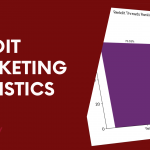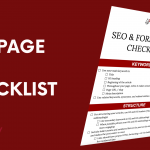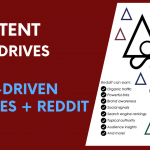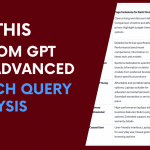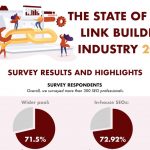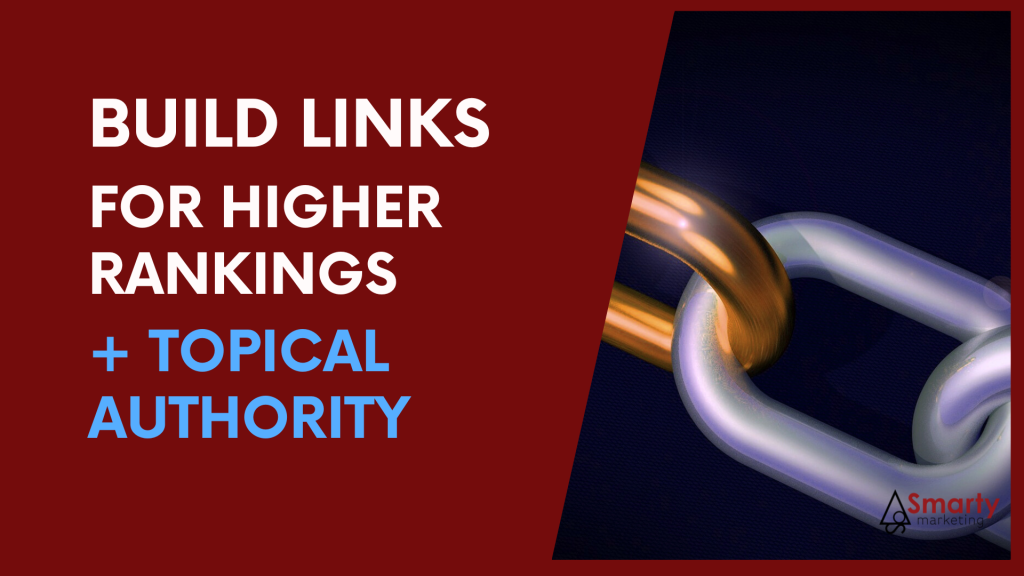
Links have been at the core of Google’s algorithm from day one. For years, Google has been using links as “votes”, i.e. if you link to a page, you “vouch” for its quality, just like citations are being used to evaluate the impact or influence of academic work in science (I think this is where Google founders got the initial idea). In science, this is referred to as “Citation impact or citation rate”.
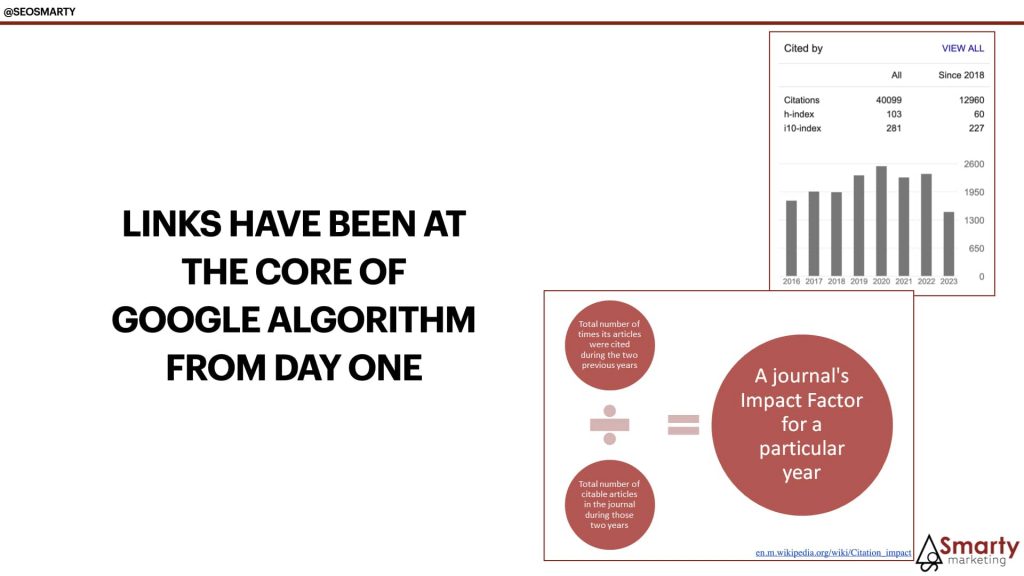
In the beginning, this was mostly about the quantity: The more backlinks, the better. Likewise, the more backlinks a page had, the more link equity it was able to pass. That link equity is referred to as “PageRank” and Google used to provide a visual representation of each page PageRank. Now it is non-public information.
Over the years Google’s algorithm has been adding other factors to fight link spam and to be able to highlight more valuable/editorial/relevant links, etc. Hence Google introduced all kinds of penalties to fight manipulative link-building tactics. (Now Google seems to simply ignore links it deems not good enough).
These days backlinks remain key factors influencing rankings both directly and contributing to other signals:
- Trustworthiness (Your page may be considered more trustworthy if it is referenced by other trusted sources)
- Part of knowledge graph (Your site or you may become entities because other entities reference you)
- Authorship (When your content is referenced by others, you build up topical authority)
All links are different and they all impact your rankings in different ways. And because of that people assume links are losing power. Well, links are still key to rankings (like they used to).
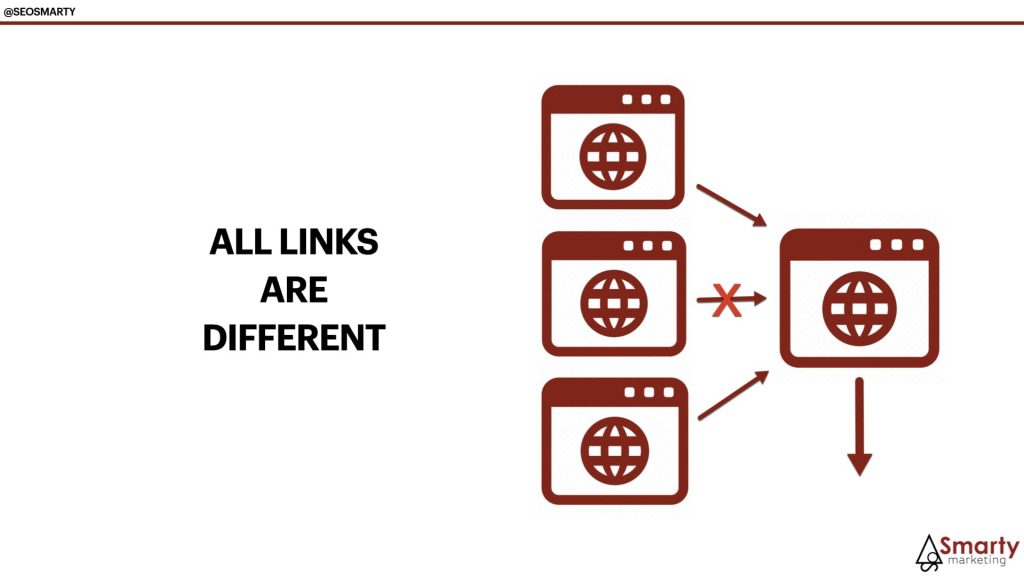
The difference is that not all links are counted these days. Different links send different signals. But what are all those differences? The fact is, we don’t know for sure. But here’s what we know, from Google’s documentation, Googlers’ statements, and decades of experience.
In this article:
Link building concepts to be aware of:
DA: Not a signal

I thought it would be funny to start with a no-signal… DA (DR) is not created by Google and it is not being used in the algorithm. Google has stated there is no such metric as domain authority. Page Rank has never been about domains. It has always been assigned on a page level.
PA
This is closer (in concept) to the original PageRank, meaning that it is on page level but it still has nothing to do with Google’s algorithm.
Link equity
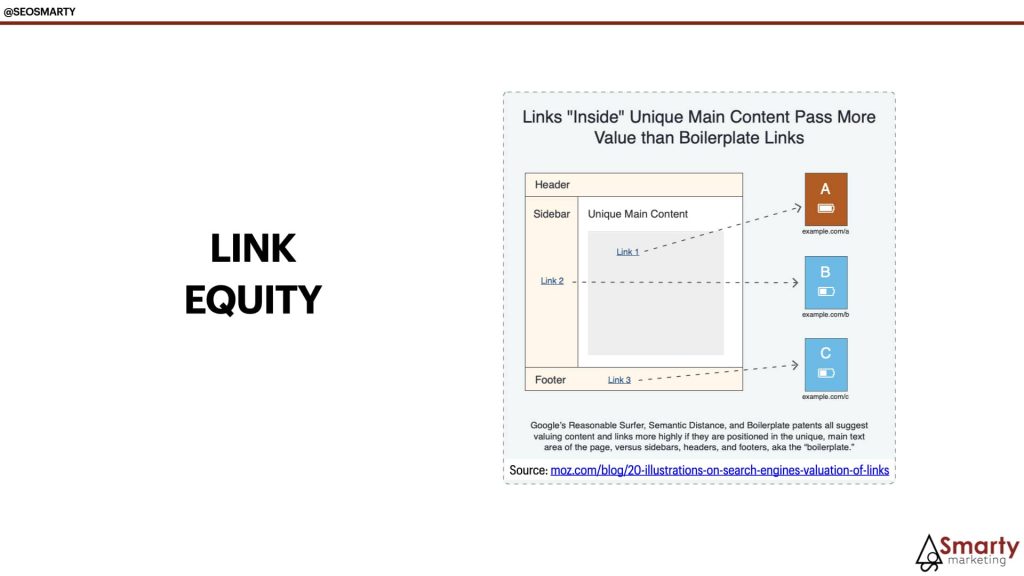
Link equity or “link juice” is a level of authority/value that is passed from a linking page to the page or pages it links to. It can be passed through both internal (i.e. links to the same pages within the same domain) and external links (links to other sites). There is no formula to calculate or estimate link equity.
We have educated theories and tests to assume links can pass different levels of link equity. It is believed that unique contextual links can pass more value than links in the sidebar or navigation.
Page relevance
There’s no metric to measure page relevance but you know when you see it. Links from relevant content are more likely to do positive things for your rankings.
Site relevance
Officially Google states that they judge relevance on a page level. But from their other statements and updates, we know that they do classify entities (sites) into categories, so the overall topic of the site (as an entity or topical authority) must also play an important role in relevance signals.
Neighborhood
When your page is referenced alongside another page (and this happens often), these two pages may be related.
Link neighborhood is often discussed in a negative context, e.g. when your link is in a bad neighborhood of known link sellers. This is why you need to stay away from link networks: Creating those patterns makes it easier for Google to discount links that tend to be appear within the same network.
Again, to the best of my knowledge, Google never confirmed they are using link neighborhood in their algorithm but this just makes sense.
Co-citation
Like links themselves, co-citation goes back to academic papers where authors are evaluated based on citations their papers generate. If A and B are both cited by C, they are likely to be related to one another, even though they don’t directly reference each other.
If A and B are both cited by more pages, they have a stronger relationship. According to Wikipedia, in scientific literature, “co-citation is the frequency with which two documents are cited together by other documents”.
There’s no official confirmation from Google that it uses co-citation when evaluating links but there are quite a few factors that have made us believe they do:
- Links/citations are a foundational aspect of document analysis
- It has the same academic roots as the whole “links as votes” concept is
- Co-citation is harder to fake because it is earned, while anchor text may be created by the website owner
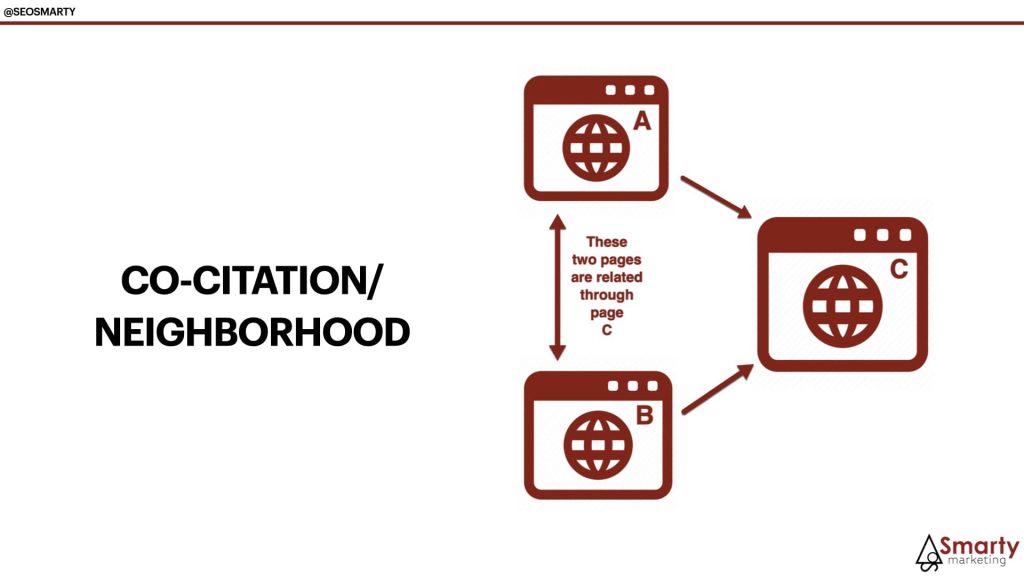
Anchor text
Anchor text is a visible and clickable part of a link. Anchor text is a confirmed Google’s signal. For example, when talking about anchor text of internal links, John Mueller (Google’s search relations team lead) has stated three important points:
- Just like with external anchor text, internal anchor text helps Google understand what the linked page is about
- The context around that link is secondary, its anchor text is a much stronger signal. This statement also makes it clear that Google also uses the surrounding text of the link.
- When an image is linked, its alt text acts as anchor text.
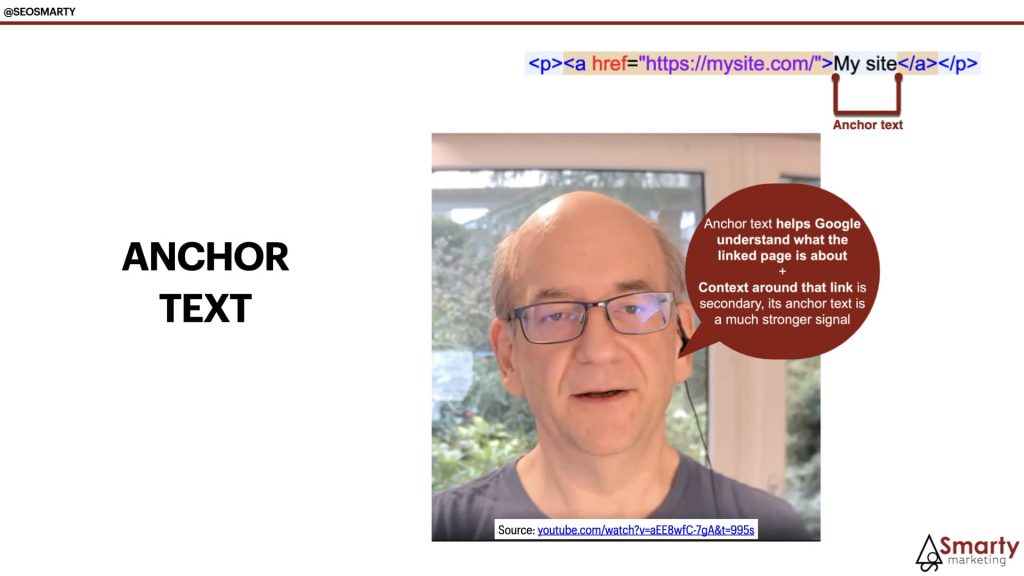
Keywords in anchor text still play a significant role in rankings. BUT Because anchor text has been so much manipulated, the white-hat rule of thumb is: “If you can control the anchor text, this link may be considered a manipulation”.
Nofollow
We have had a long and complicated history with the nofollow link attribute. Originally Google (and other search engines) introduced it to let website owners label links they don’t “vote for” (like sponsored and user-generated links).
Google has recently announced they will be using the attribute as a “hint” which probably means nofollow links may still pass link equity. At this point, my recommendation is not to pay attention to whether the link is nofollow or not. Just go for either.
Link building tactics
Broken link building
As the name suggests, you find broken links in your niche and reach out to the publisher to suggest your live resource instead.
We like to call it an “ethical” link building method because there’s got to be at least something ethical about link building, right? 🙂 On a serious note, this method is about fixing the web.
Both Semrush and Ahrefs provide tools to help you find well-linked broken URLs on any site. Another idea is to find a no longer live blog with backlinks, identify its most-linked articles, and claim those links!
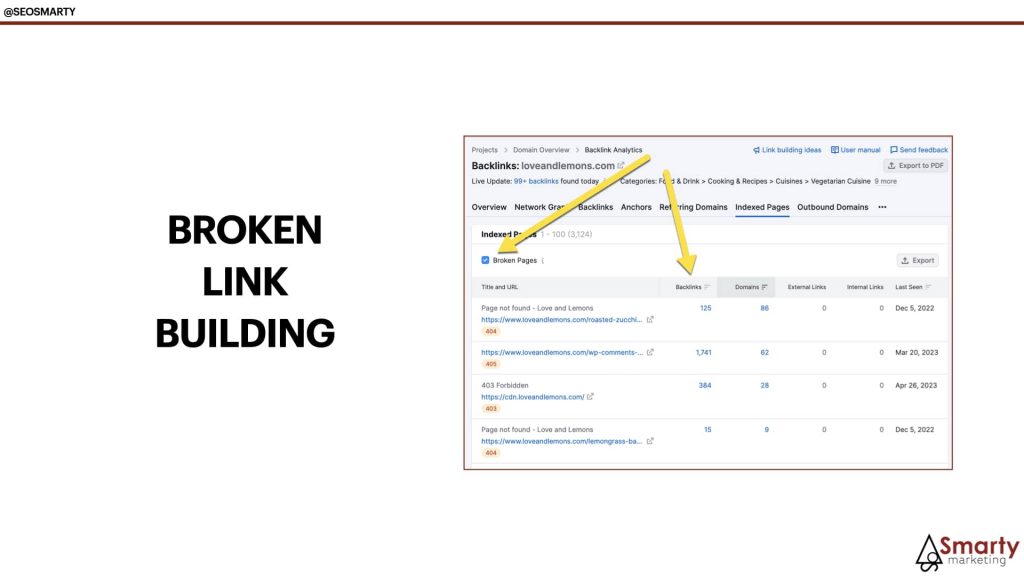
You may have an existing resource to replace the broken one or you may have to create one. Either way, it is a lot of emailing to those publishers but it usually works well.
Outdated content link building
This is similar to the broken link building but you reach out to publishers to update their outdated content with yours which is more recent (and includes more recent research, tips, etc.)
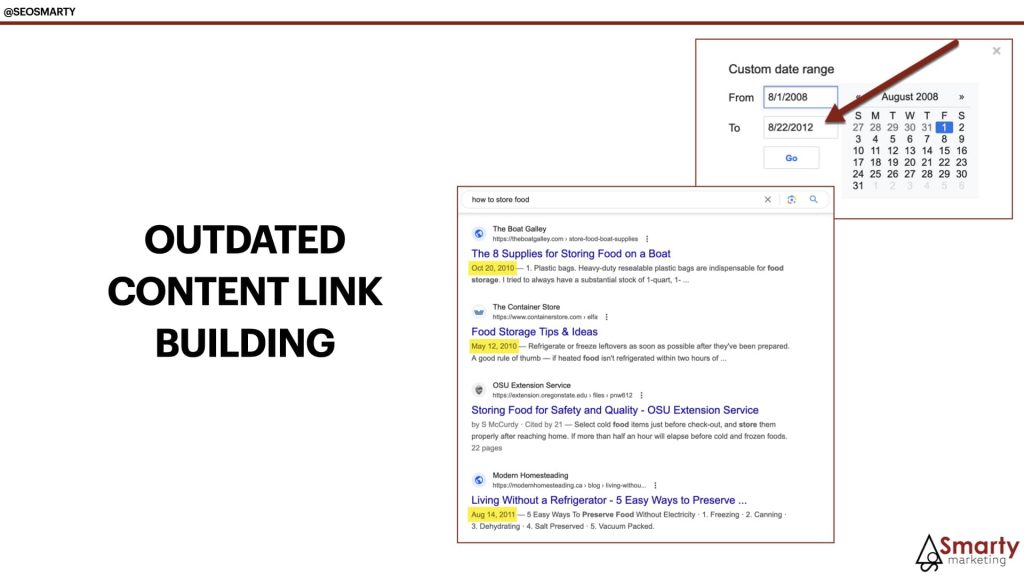
Google helpfully provides a timeframe search option allowing you to filter results based on a customer time frame. When searching Google, click “Tools”, or “Any time”, and select your timeframe.
Podcasts/Interviews
Being interviewed is a great way to generate links as well as get your brand associated with well-known entities in the niche.
It also has a snowball effect: The more you are interviewed, the more pitches you are going to receive to be more interviewed. Buzzsumo is a great way to find those podcast/interview opportunities:
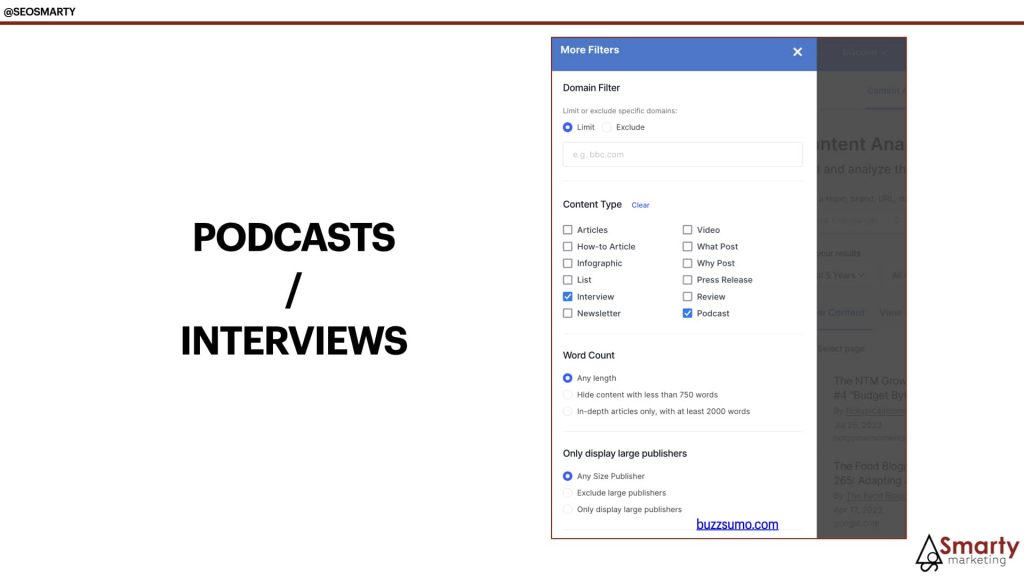
Just search for your fellow blogger’s name and select “Podcasts” and “Interviews” as filters. You can also customize the timeframe to find more recently published interviews: These hosts are likely to be more responsive as they are still actively publishing new episodes.
Guest blogging
Guest blogging has a long and complicated history with Google where it first didn’t mind it as a link-building tactic, then decided to penalize it as a link building tactic. But to this day, it remains a great tactic to build your niche authority and backlink profile.
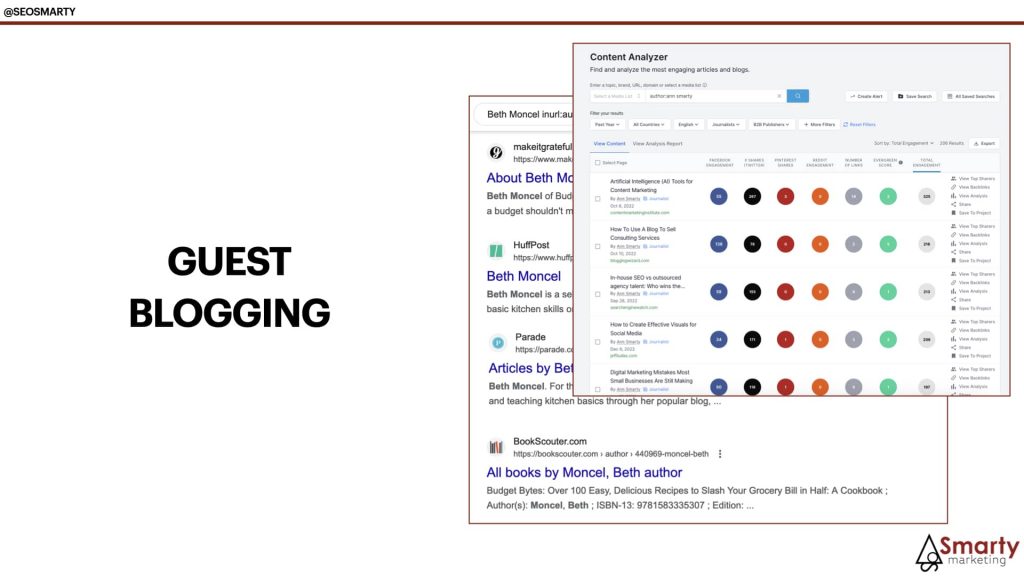
The key is to find reputable and high-traffic sites to write for on a regular basis to build your name and benefit from recurring links. When writing for these huge sites, try to link to your content from within content (if editors don’t mind). This will send deep contextual links to your site – and this is great! Again, Google is a great place to find those opportunities.
Try searching for your more established or more active fellow bloggers and reach out to editors expressing your interest. This is the search query to start with: [Blogger Name inurl:author] – this will help you find that blogger’s columns.
Roundup link building
One of the more popular link building methods – you give me links and I’ll give you links. It is often done through Facebook, Skype groups, or Slack. There’s nothing inherently wrong with it but it takes much time and the power of these links remains questionable as you keep getting the same links from the same neighborhood over and over again.
Your time may be better spent. It is ok to do from time to time. But don’t make it your only link-building method. When you provide links from other sites instead of your own, it could work much better.
Digital assets (visualizations, linkable content)
These could be
- Infographics
- Surveys/cheatsheets
- Free downloads (free cookbooks or meal planners), etc.
They are sharable and can attract links (if you couple them with outreach). They can also rank driving consistent links over time (which is the goal).

Research / Surveys / Whitepapers
Similar to digital assets, but based on your own data.
You can poll your readers or social media followers (or use services like Pollfish) on interesting and timely questions and put together a mini-research.
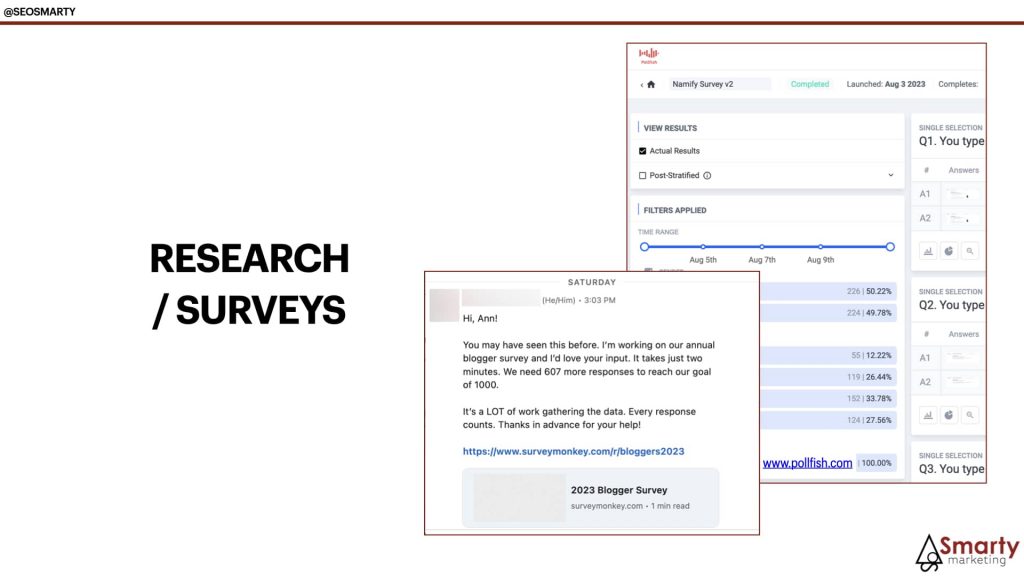
Journalist outreach (HARO+Buzzsumo)
Lots of great content won’t get any links, simply because it won’t be seen by content amplifiers (editors, publishers, bloggers, and reporters). This is why journalist outreach is so important.
HARO is a freemium service connecting reporters and publishers to experts. It sends free emails containing requests for expert opinions and contributions.
Buzzsumo has a cool filter called “Journalists” allowing you to find content written by reporters. It is a great way to find journalists reporting on topics you are blogging about as well as access more information on them (like social media channels and email addresses).
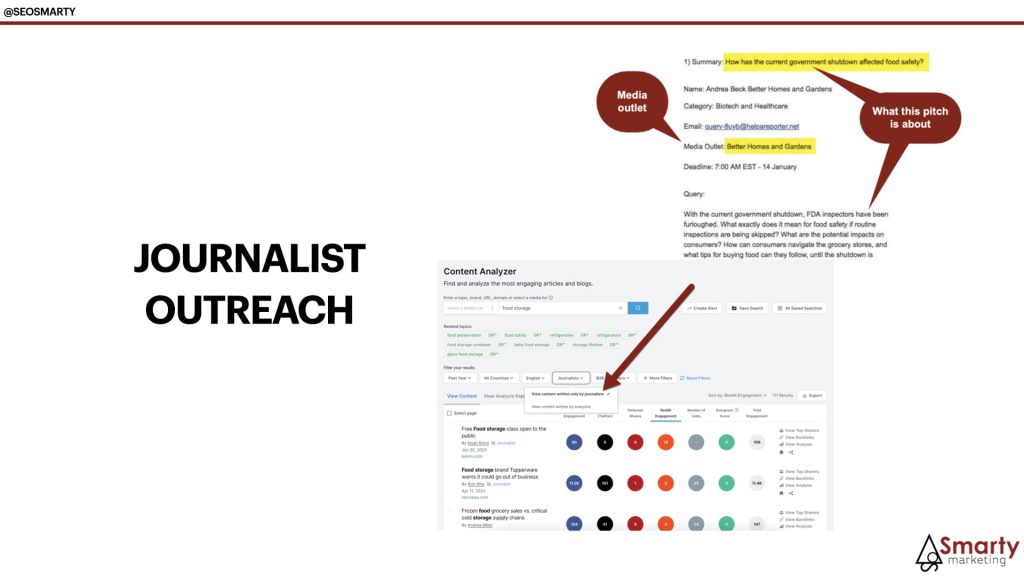
Don’t just end your relationship with journalists after a successful feature or a link. Keep track of those who respond because you’ll be able to pitch them new assets to link to in the future, like interesting and timely content you create – which takes us to the next item here:
Trends
Covering and responding to trends is a great way to generate links. TikTok is a great way to have some coverage on major outlets (especially if you have existing relationships with journalists to pitch because speed is the key here). TikTok is the first place to break out trends, so if you are already active on TikTok, you just need to create blog content around what you see there.
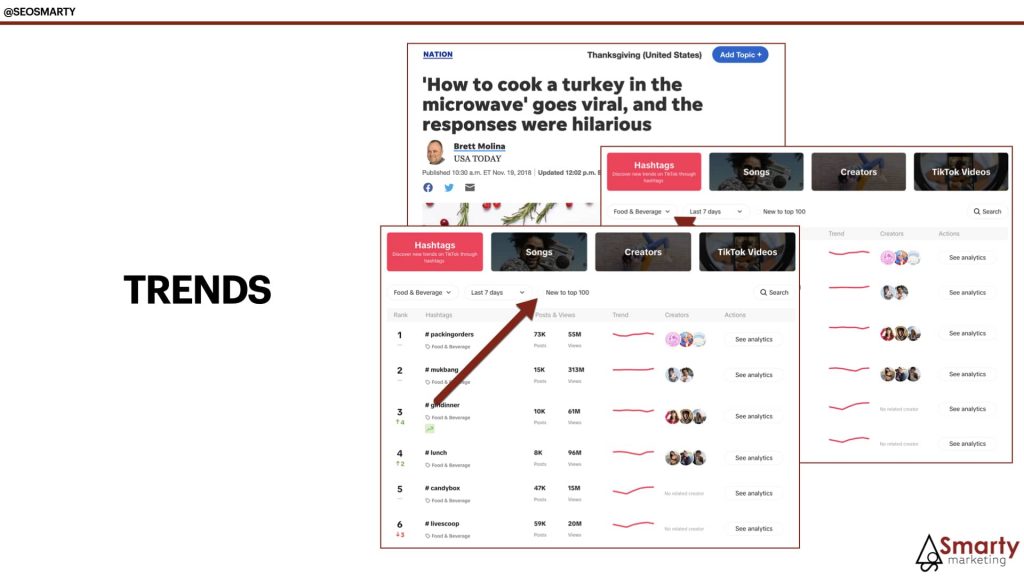
There’s also TikTok’s own tracker alerting you of current trends in any of the chosen categories. To see the newest trends there, check the “New to top 100” option.
Listicles/Co-citation
Being included in the related lists is good for the brand and it also builds your link neighborhood (your links appears next to high-authority links in the niche) and co-citation (i.e. you and recognized brands in that niche are being referenced by the same pages again and again).
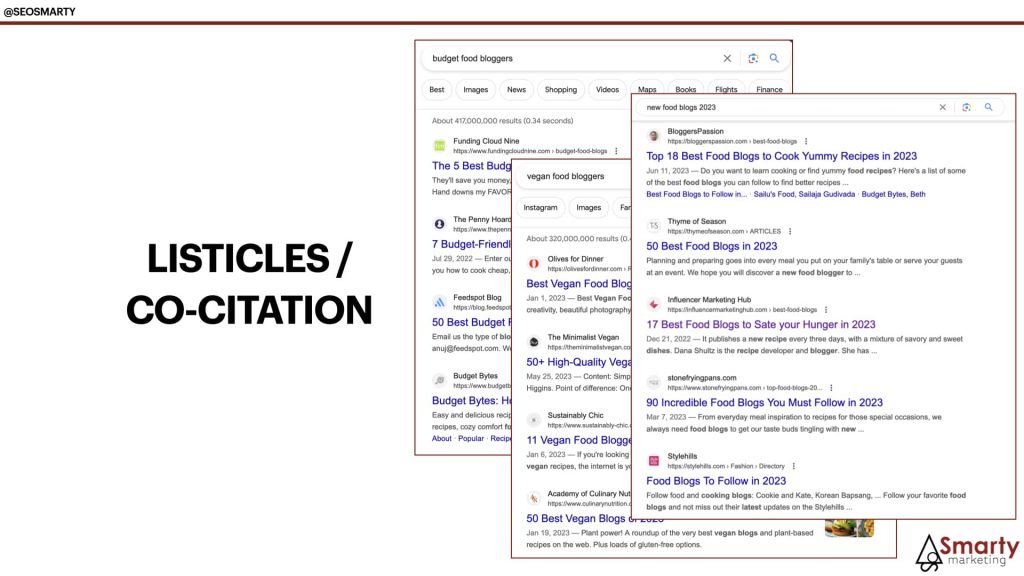
It also has that snowball effect too: Those lists are being repurposed from blog to blog, so once included, you have better chances to be linked in the next link. Searching for those lists regularly and reaching out to bloggers is a recurring task.
OUTREACH
A lot of the tactics above mention “outreach” as a way to reach out to publishers, bloggers, and journalists. Here are a few ways to make your outreach more effective:
Gmail templates
I don’t like using outreach tools. I don’t recommend against trying one (maybe you’ll be luckier than I was) but personally, I feel more in control of the process when I do outreach manually. When you use those tools, sometimes you email weird companies, so you may end up facing this citation 🙂
So I email manually. To make things faster you can use Gmail’s templates to put together emails.
ChatGPT
It is also not a bad idea to use ChatGPT to create those templates. It usually takes me a couple of prompts to get an email template I can work with but it is easier than writing those emails from scratch. I never use them without editing or customizing but a couple of prompts can get you some good results to go on with.
Search for that blogger/journalist on Google
- Connect to them through their personal site
- Find a better email address
- Follow them on social media (and curate these contacts through Twitter lists)
- Find something cool to mention in the email (and get their attention)
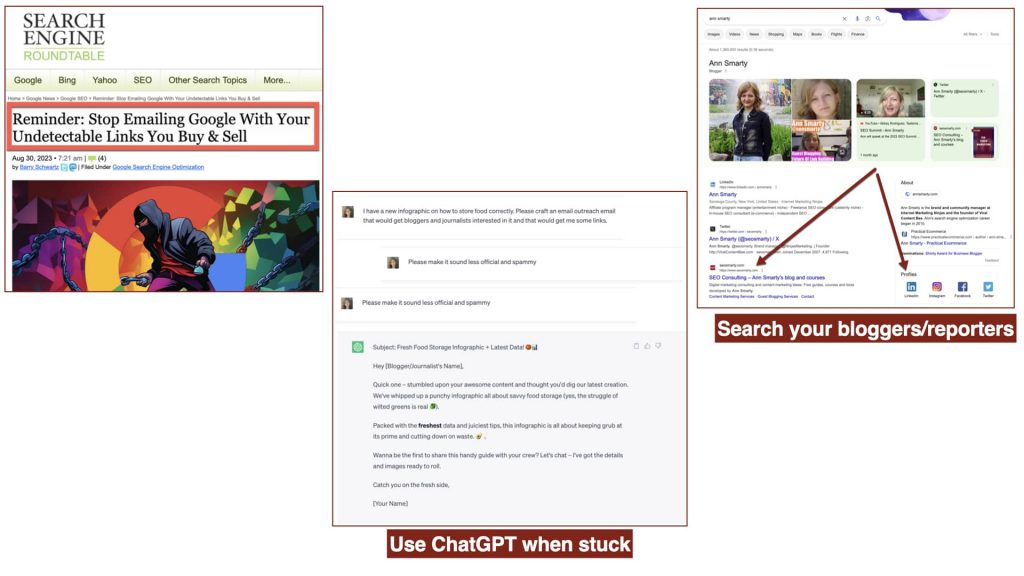
Ego-baiting
Ego-baiting is a general tactic of creating a more noticeable pitch by mentioning familiar names. Something like
- This infographic was featured in [put the name of a well-known publication here]
- This article has an expert contribution from… [put a well-known blogger here]
- etc.
To sum up: Link Building Tactics
| Link building tactic | Tools to use | Most effective |
| Broken link building | Semrush/Ahrefs (or both) | When combined with other methods (e.g. replace a dead infographic or listicle) |
| Outdated content link building | Google’s “date” search | When updating old data (see “research/surveys” tactic) |
| Podcasts/Interviews | Buzzsumo, Google search | When targeting high-traffic sites |
| Guest blogging | Google [“Author Name” inurl:author] search, Buzzsumo “Author:” search | When maintaining consistent columns on highest-authority outlets |
| Roundup link building | Skype/Slack/Facebook groups, etc. | When you don’t overdo it, + when you are picky with where you are linked from or who you link to |
| Digital assets (infographics, whitepapers, etc.) | Buzzsumo, Pinterest, Google search | When you target “content amplifiers” (reporters, bloggers, etc.) rather than your readers + When you use Reddit for link building |
| Original research (surveys, reports, etc.) | SurveyMonkey/Pollfish | When updating existing outdated research/reports |
| Trends | TikTok, Reddit | When covering news/topics very quickly as it starts trending |
| Listicles / Co-citation | Google search, Buzzsumo | When you add associated ego-baiting (“My blog was already featured by…”) |
| Journalist outreach | HARO, Buzzsumo | When combined with linkable assets, i.e. infographics, reports, etc. |
